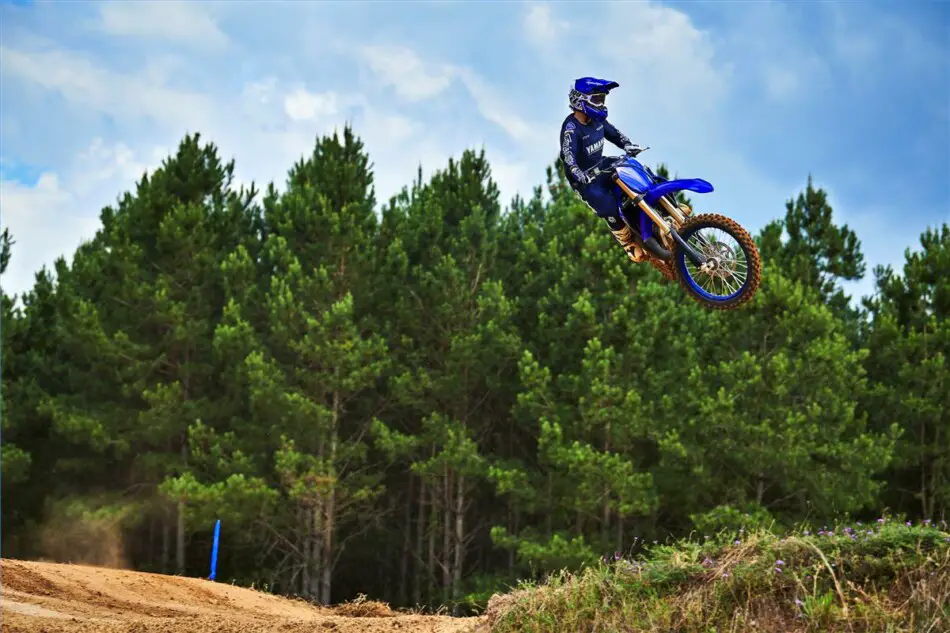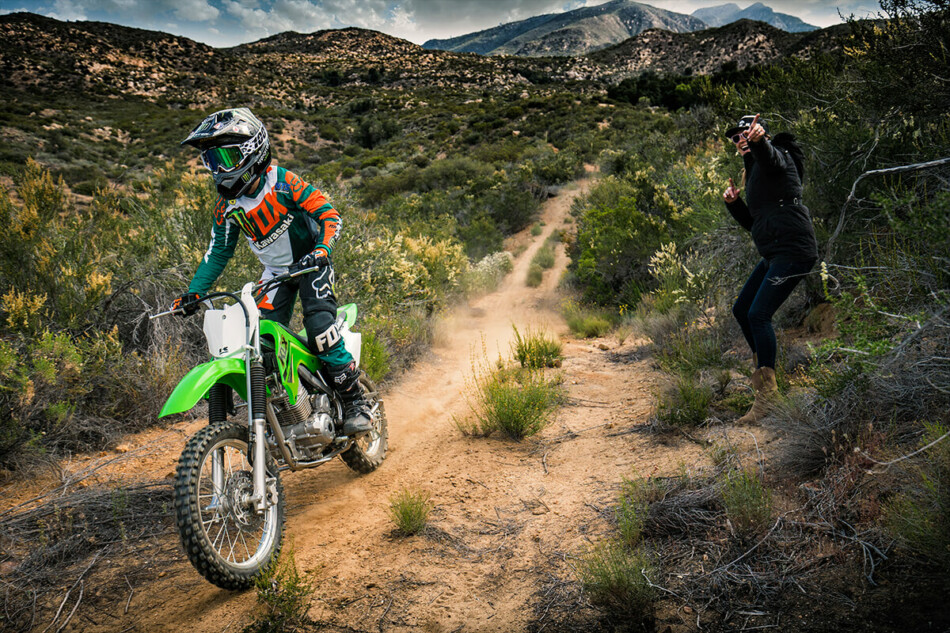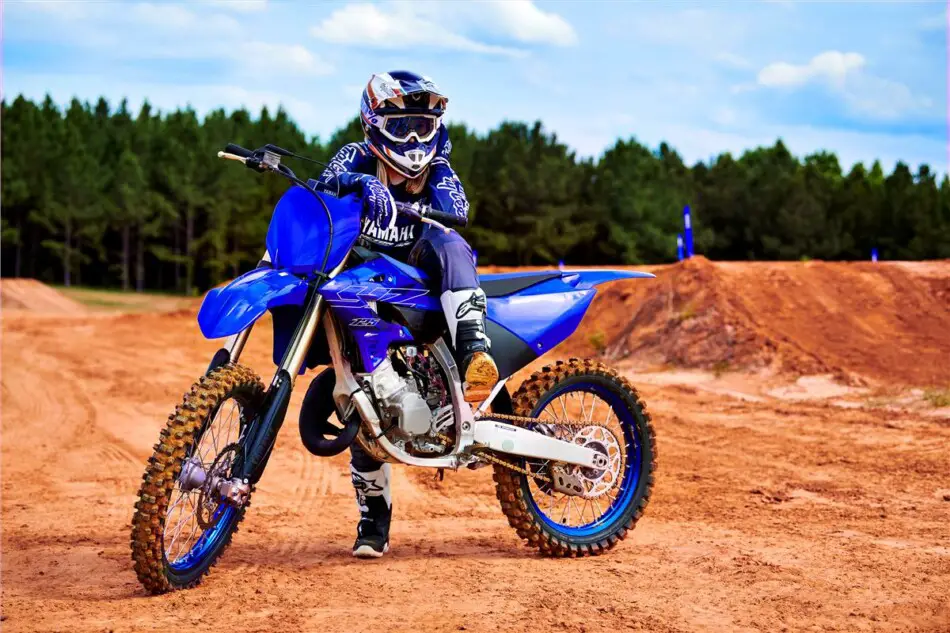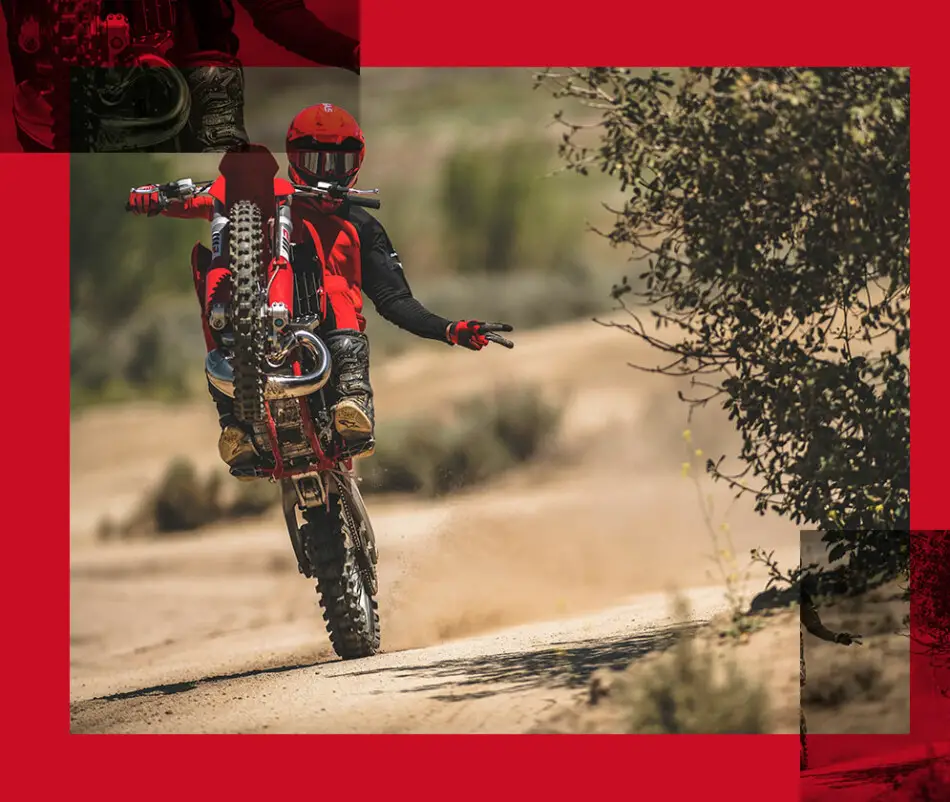Choosing the right dirt bike can be difficult, especially if you haven’t owned one before. There are just so many different models of dirt bike available to choose from.
The best you can do is to go and test ride as many bikes as possible. If the dealers aren’t willing to let you ride a new bike, try jumping on a friend’s dirt bike. If you can’t get a dirt bike to test, at least go and sit on a few models before making your decision.
In the meantime, let’s have a look at 10 factors to consider before buying the right dirt bike for you.
#1: Rider Experience Level
If you are reading this, you probably haven’t owned a dirt bike before. Maybe you have experience with sports bikes or adventure bikes and want to get a dirt bike to play around with.
A common mistake beginner riders make is to go for the most powerful dirt bike they can afford. They are worried that they will outgrow a slower bike and therefore want a dirt bike they can ‘grow into’ as they progress their skills. I’ve made this mistake.
The fact is, it is so much easier to learn on a less intimidating motorcycle. You will learn faster if you have more confidence on the bike and you will become a better rider sooner. And believe it or not, it is always more fun to ride fast on a slow bike, than it is to hold back on a too powerful bike.
While you are still learning (and as you ride more technical terrain), you will also drop the bike every now and then. The lighter and smaller the bike, the easier it will be to pick up. Start with something you feel comfortable on and consider what you will use it for.
#2: Intended Use and Terrain
There are so many different styles of riding you can do on a dirt bike. Some riders want to fly around a motocross track or blast down a single track in the woods. Others prefer slow, technical riding over obstacles, up rocky mountains, or over the boulders in a dry river bed. Choosing the right dirt bike for the type of riding you intend to do will ensure that you progress quicker and have more fun.
If you plan on racing the bike, a 125 cc or 250 cc 2-stroke or 250 cc or 450 cc 4-stroke competition machine it probably best. We’ll chat about the differences between 2-stroke and 4-stroke in a moment. Competition dirt bikes, like the Yamaha YZ250, are built to ride hard, fast and over massive jumps.

These bikes have very tall seat heights due to their long travel suspension. While you can still ride slow, technical terrain on a competition bike, you will have a hard time putting your feet on the ground when losing your balance, except if you are very tall.
If you plan on riding the trails with your friends and exploring woods, a less aggressive dirt bike may be a better place to start. Something like the Kawasaki KLX 230 R or Yamaha TT-R 230 will have a lower seat height to inspire confidence when the going gets tough. These small capacity four-strokes will also not throw you off if you grab a handful of throttle by accident.
I’ve recently explored a dry river bed with my old Yamaha AG 200 farm bike. It took be 4 hours to cover only 25 miles, and even though the bike is slow as hell, it was the most fun I’ve had on two wheels in a long time.
For fast desert racing or riding in the dunes, a large capacity four-stroke is probably your best bet. Any of the 450 cc four-strokes will be perfect, or you might even go for something bigger like an enduro bike.
#3: Rider Height and Weight
The average competition dirt bike has a seat height of 37 inches, putting them out of range for all but the tallest riders. For a comprehensive post on seat height (including a table that lists all the seat heights of all the dirt bikes), check out this post of mine. If you can ride, seat height doesn’t matter, but if you are still learning it can be very intimidating.
As a beginner rider, you want to be able to at least put both feet on the ground at the same time. You don’t have to flatfoot it on both sides, but you need to be able to at least hold the bike upright without worrying that you’ll topple over. Heavier riders will compress the suspension more, which will make it easier to reach the ground. Short, lighter riders often have more difficulty on dirt bikes.
If you are a shorter, lighter rider (like my wife) it is best to start off on something like a Kawasaki KLX 140 R with a seat height of 33.9 inches and a smaller capacity engine. Once you get more comfortable balancing the bike during slow, technical riding or when coming to a stop, you can upgrade to a taller, more powerful bike.

If you are tall, heavy, and intend to jump the bike often, rather go for a bike with better suspension to soak up the landings. Any of the bigger competition machines (250 cc 2-stroke or 350/450 cc 4-stroke) will be more suited to take the abuse.
#4: Engine Size and Power
Faster and more powerful is always better, right? Wrong! If you are only starting out on a dirt bike for the first time, the power band of a 250 cc two-stroke or the torque from a 450 cc four-stroke will be very intimidating. You will most likely have to hold back most of the time, which is hardly the best way to hone your riding skills. Starting off on a less powerful bike will instill confidence while still learning to ride and as you progress, you will have to push harder to squeeze out more performance.
Having to work harder to ride fast on a less powerful bike will hone your skills which will transfer well to a more powerful bike when you are ready. That said, a dirt bike with more low-down torque will be easier to ride slowly. On a Yamaha YZ 250 2-stroke for instance, you’ll be able to ride slowly at small throttle openings. It is only if you grab a fistful that you’ll get a kick in the pants.
On a less powerful YZ 125 you will struggle to get anywhere with a small throttle opening and therefore have to use the clutch more to get into the power band. This will require more skills and possibly be frustrating for new riders, but it will make you a better rider in the long-term.
As you can see, there are many factors to consider and a lot of trade-offs. For the complete beginner, I suggest a smaller 4-stroke with a more predictable torque curve.
#5: 2-Stroke vs 4-Stroke
There are some major differences between 2-stroke and 4-stroke dirt bikes. We won’t go into all the details in this post. Instead, let’s look at the practical differences between them when choosing your first dirt bike.
Two-stroke dirt bikes are generally a little lighter than an a similar-sized four-stroke. As an example, the 2-stroke KTM 250 SX weights 210.5 lbs (95.5 kg) while its 4-stroke cousin, the KTM 250 SX-F is only 8 lbs heavier at 218.3 lbs (99 kg). This is due to more moving parts in the engine, including a camshaft, rockers and valves.
Two-stroke bikes deliver more torque per cc of engine capacity than 4-strokes. That is why you often see 125 cc 2-stroke dirt bikes compete with 250 cc 4-strokes, or 250 cc 2-strokes, with 450 cc 4-strokes. The way the power is delivered is also very different. A two-stroke dirt bike has a very steep, but narrow torque curve, often referred to the power band.
A four-stroke dirt bike has a much more linear torque curve which starts just off idle. Therefore, a four-stroke is often easier to learn on for a beginner rider, as he/she doesn’t have to use as much slipping of the clutch to get into the power band. A four-stroke also offer more engine braking than a two-stroke, which makes it better for very steep downhills.
If you’ve never experienced the difference between two-strokes and four-strokes, I strongly recommend that you take both types of dirt bike for a spin before making your decision.
#6: Budget and Maintenance
Since a two-stroke has fewer moving parts, they are also cheaper to maintain. There are no valve clearances to set and a top-end rebuild only requires a piston, ring and gasket set.
Most modern dirt bikes are liquid-cooled, regardless of whether it is two-stroke or four-stroke, but there are some air-cooled bike that you can buy new, like the Kawasaki KLX 140 R. An air-cooled motor doesn’t have a radiator and water-pump that can fail, and therefore requires less maintenance and has less that can break in a crash.
Some modern two-stroke still run carburetors, however, while most modern four-strokes have fuel injection. A dirt bike with a carburetor may need more regular maintenance, e.g. cleaning and re-jetting, and you need to remember to close the fuel tank petcock to prevent flooding. Other than that, a carburetor motorcycle is as reliable as a bike with EFI.
The high-end competition dirt bikes will require more frequent valve clearance adjustments and top-end rebuilds than the lower-powered recreational machines or the ‘farm bikes’. If you are into exploring in the woods and short moto-camping trips rather that tearing up the motocross track, I’d go for a off-road bike like the Kawasaki KLX 300 R instead of the competition KX 250 F.
If you plan on riding long distances at wide open throttle, a four-stroke is the way to go. Two-stroke engines do not like riding at high, constant rpms for extended periods of time. It can be done, but it will put more strain on the engine.
#7: Seat Height
On of the biggest issues that beginner dirt bike riders face is the tall seat heights. I wrote a whole post cover everything there is to know about dirt bike seat heights, including a table listing all the modern dirt bike seat heights. You can read that post here.
The average dirt bike has a seat height is 34 inches (863 mm), which is taller than 80% of all the motorcycles I could find. With a seat height of 38.6 inches (980 mm), the Yamaha YZ125 is the tallest dirt bike, while the Yamaha PW50 kiddies bike has the shortest seat height of 18.7 inches (475 mm).

The best is to go and sit on the dirt bikes on your shortlist or better yet, take them for a test ride if possible. Dirt bikes are tall due to long travel suspension, big wheels for off road riding, and a neutral seating position.
If you are just starting out, it may be worth it to learn on a shorter bike until you gain confidence. Once you are comfortable with the clutch control and coming to a stop, you can move to a taller dirt bike. There are a variety of tips that will help shorter riders handle their tall dirt bikes. You can read all about it here (I’ll link the post once it is done!).
#8: Dirt Bike Weight
Dirt bikes are the lightest type of motorcycle that you can buy. The average dirt bike weights only 217 lbs (98 kg) and the heaviest dirt bike (the Kawasaki KLX 300 R at 282 lbs) is still much lighter than the average motorcycle of any type (at 451 lbs).
Dirt bikes are kept as light as possible in order to make them faster and more capable on a motocross track or in technical terrain. Many dirt bikes have aluminum frames and engines to keep the weight down. They also don’t have fancy dashboards, lights, and other luxuries that weight them down.
Due to the light weight of dirt bikes, they are easier to balance and move around, despite their tall seat heights. And when (not if) you drop your dirt bike, it is easier to pick up again without assistance from other riders. Something that cannot be said of dual sport and adventure bikes!
#9: New vs Second Hand
If you are a complete beginner that has never ridden a motorcycle before, I would definitely recommend getting a second-hand dirt bike to learn on. You are guaranteed to drop the bike a few times, especially if you are not very tall. You can then sell it when you buy a new bike when the time comes and you’ll lose less on depreciation.
Dirt bikes tend to live hard lives due to the terrain they are ridden in and the nature of the sport. You can expect a second hand dirt bike to be full of scratches from behind dropped. Look out for leaking fork seals, cracks in the engine side covers, and broken or missing plastics.
The drive train is another area that needs careful inspection. Since dirt bikes are ridden in the dirt (duh!), the chain and sprockets will wear faster, especially if it was not cleaned regularly (after each ride). While these components are easy to replace and that expensive, it can quickly add up and can be used to negotiate a better price.
New dirt bikes are expensive, but at least you get a warranty from the factory and you know what you are buying. I’d personally wait until I have honed my skills and feel confident on the terrain I will ride most frequently.
#10: Which Brand of Dirt Bike To Buy
In my honest opinion, just get a Japanese dirt bike. I am currently looking to buy a Yamaha YZ 250 and my main motivation is Yamaha’s reputation for reliability. There’s nothing wrong with the other three, however. Like I’ve said earlier, go test ride the bikes or sit of them at least.
The European brands like KTM, Gas Gas and Husqvarna are amazing machines and can be every bit as reliable as their Japanese counterparts with regular maintenance. They do, however, have a reputation of being more expensive to maintain and more difficult to find replacement parts for, but also for being more fun to ride.
Incidentally, these three brands have exactly the same seat heights and weights for the same engine sizes (see the table in this post).

In short, if you have the cash, but the bike you like most. If you are on a budget, buy a Japanese dirt bike.
Conclusion
What is the best (only) way to make sure you buy the right dirt bike? Go ride them all and pick the one that you fall in love with. Otherwise, just buy the one you feel suits your intended riding style and experience level best (based on the factors above), and then sell it and buy the next one once you feel like it. That’s my strategy anyways.
Happy riding!
